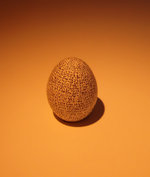Tehom

Tehom (Hebrew: תְּהוֹם təhôm) is a Northwest Semitic and Biblical Hebrew word meaning "the deep” or “abyss” (literally “the deeps”).[1] It is used to describe the primeval ocean and the post-creation waters of the earth. It is a cognate of the Akkadian words tiāmtum and tâmtum as well as Ugaritic t-h-m which have similar meaning.[2] According to a theological dictionary, tehom derives from a Semitic root which denoted the sea as an unpersonified entity with mythological import.[3]
Genesis
[edit]Tehom is mentioned in Genesis 1:2, where it is translated as "deep":
And the earth was without form, and void; and darkness was upon the face of the deep. And the Spirit of God moved upon the face of the waters.
The same word is used for the origin of Noah's flood in Genesis 7:11:
In the six hundredth year of Noah's life, in the second month, the seventeenth day of the month, the same day were all the fountains of the great deep broken up, and the windows of heaven were opened.
Gnosticism
[edit]Gnostics used Genesis 1:2 to propose that the original creator deity, called the Pléroma "Totality" or Bythós "Deep" preexisted Elohim and gave rise to such later divinities and spirits by way of emanations, progressively more distant and removed from the original form.
In Mandaean cosmology, the Sea of Suf is a primordial sea in the World of Darkness.[4][5][6]
Kabbalah
[edit]Tehom is also mentioned as the first of seven "Infernal Habitations" that correspond to the ten qlippoth (literally "peels") of Jewish Kabbalistic tradition, often in place of Sheol.
Sanchuniathon
[edit]Robert R. Stieglitz stated that Eblaitic texts demonstrate the equation of the goddess Berouth in the mythology of Sanchuniathon with Ugaritic thmt and Akkadian Tiâmat, as the sea was called tihamatum, and also buʾrâtum = Canaanite beʾerôt ("fountains").[7]
See also
[edit]References
[edit]- ^ Waschke 1974, pp. 577–579.
- ^ Tsumura, David Toshio (1989). The Earth and the Waters in Genesis 1 and 2: A Linguistic Investigation. A&C Black. p. 52. ISBN 978-0-567-40277-6.
- ^ Waschke 1974, pp. 574–575.
- ^ Aldihisi, Sabah (2008). The story of creation in the Mandaean holy book in the Ginza Rba (PhD). University College London.
- ^ Al-Saadi, Qais Mughashghash; Al-Saadi, Hamed Mughashghash (2012). Ginza Rabba: The Great Treasure. An equivalent translation of the Mandaean Holy Book. Drabsha.
- ^ Gelbert, Carlos (2011). Ginza Rba. Sydney: Living Water Books. ISBN 9780958034630.
- ^ Stieglitz, Robert R. (1990). "Ebla and the Gods of Canaan". In Cyrus Herzl Gordon; Gary Rendsburg (eds.). Eblaitica: essays on the Ebla archives and Eblaite language. Eisenbrauns. pp. 79–90 (p.88). ISBN 978-0-931464-49-2.
Sources
[edit]- Waschke, Ernst-Joachim (1974). "tehôm". In Botterweck, G. Johannes; Ringgren, Helmer; Fabry, Heinz-Josef (eds.). Theological Dictionary of the Old Testament. Eerdmans. ISBN 978-0-8028-2339-7.



